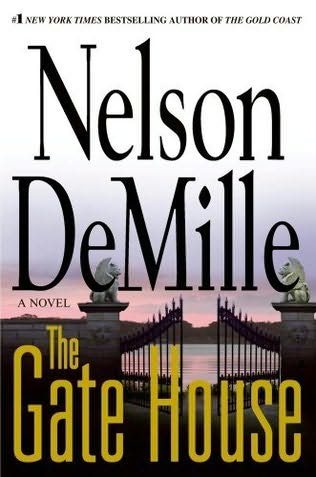‘The Gate House’ by Nelson DeMille

That 1990 novel was arguably the New York writer’s finest work, and the critical acclaim he received helped push his career into the
stratosphere. Two of his most popular books, “The General’s Daughter” and “Plum Island,” soon came after.
The strange thing is, “The Gold Coast” was a stand-alone novel: a drama involving two families on New York’s fabled, wealth-encrusted Gold Coast on the north shore of Long Island. His other books have been filled with recurring characters and lots of action and intrigue.
“The Gold Coast” was unique, because it was slower paced, had richer dialogue and deeper character development. It had a marvelous “The Great Gatsby”-esque quality to it, except it was more complicated and violent. And DeMille threw in enough plot twists, especially the end events, to keep readers entertained.
As a result, I was not looking forward to reading DeMille’s follow-up to “The Gold Coast.” I assumed “The Gate House” could not live up to the standard of the original. After all, sequels in books and movies rarely do. In the introduction to the reissued “The Gold Coast,” DeMille writes “after nearly twenty years of being begged, badgered, and bullied by readers about continuing this story, I got up the courage to try to top my best book.”
The verdict: “The Gate House” is definitely not as good as “The Gold Coast” but it’s a strong effort. It has a lot going for it in the first
few hundred pages — main characters returning, a few new ones are introduced and some surprises. But inexplicably, DeMille bonks about two-thirds of the way through, and the last third of the novel is long-winded and very predictable. The ending, quite frankly, was a disappointment. The 688-page story should’ve been hacked down to about 500 or less.
I got the feeling that DeMille had a really good idea for the story (and he successfully fleshed it out), but he didn’t know how to end it.
It appears he went the easier, faster route. But “The Gate House” should please enough DeMille fans to keep it on the best-seller lists
for a while. And readers new to DeMille don’t need to read “The Gold Coast” to enjoy the sequel, although I highly recommend reading it first.
Let’s rewind: “The Gold Coast” is the story about two men, John Sutter and Frank Bellarosa, and their families who wind up on a collision course on Long Island. Sutter, a middle-age Wall Street lawyer, is married to a gorgeous, wealthy wife, Susan, who is the heir to a massive fortune and whose aristocratic family has had a major presence on the Gold Coast for decades. The Gold Coast once was the home to many of America’s richest and most powerful families, especially during the Gilded Age. Mansions, large estates, yacht clubs, etc., were the rule.
The story takes place in 1990, with the coast now a shadow of its former self. Bellarosa is a ruthless but charming Mafia don, who buys the estate next-door to the Sutters. It’s a peaceful relationship for a while, but betrayal and violence soon erupt. The Sutters get caught in the middle. Susan cheats on John, and begins a sexual relationship with Bellarosa. John saves Bellarosa’s life from a mob hit, and he becomes the don’s lawyer in an upcoming trial. It’s a classic case of sleeping with the enemy to ensure survival.
But what kind of survival? John finds out about his wife’s betrayal and grows disgusted of his relationship with Bellarosa, who is facing some serious jail time for his lifelong crimes. In the end, Susan shoots and kills Bellarosa, and the couple face a very uncertain and problematic future.
Fast forward to 2002: “The Gate House” takes place almost a year after the Sept. 11 terror attacks. John Sutter comes back to the United States to see an old faithful family servant, Ethel Allard, who is near death. Sutter now lives in London, where he has worked as a lawyer for the last several years. Before that, he went on a solo, three-year journey around the world on his sailboat. Susan Stanhope Sutter, who is the heir to her parents Stanhope estate, got a divorce from John and had been living in Hilton Head, S.C. She has now moved back to be closer to her aging parents and young adult children.
A wealthy Iranian now owns Susan and John’s former estate, but Susan has managed to buy and live in a small house on the property. The Iranian is not happy about it. John visits Allard’s small home on another side of the property, near the gate, hence the term “the gate house.” Allard’s husband has died, and she now is dying in an assisted living facility. John has come back to temporarily live in Allard’s home to deal with subsequent end-of-life legal issues.
Not surprisingly, after some awkward moments, the Sutters reconcile and seriously talk about getting married again. They want to be closer to their kids and live happily ever after. But there are problems. Susan’s super-rich, obstinate parents are dead-set against the remarriage. And John has a lucrative job offer from Anthony Bellarosa, the son of Frank who doesn’t seem to be hellbent on revenge. But does John really want to be associated with the Mafia don’s son? And does he really want to marry Susan again and risk losing a mammoth family inheritance, especially for their kids?
The answers are predictable and, not surprisingly, violence ensues.
Unfortunately, DeMille’s trademark plot twists are lacking in “The Gate House,” and there’s really not much action. DeMille ties up some loose ends from “The Gold Coast,” which is satisfying, and his sardonic wit is as good as ever. “The Gate House” suffers from too much reliving of “The Gold Coast” and not enough fresh, imaginative direction. Still, DeMille packs enough punch to make “The Gate House” worth entering.